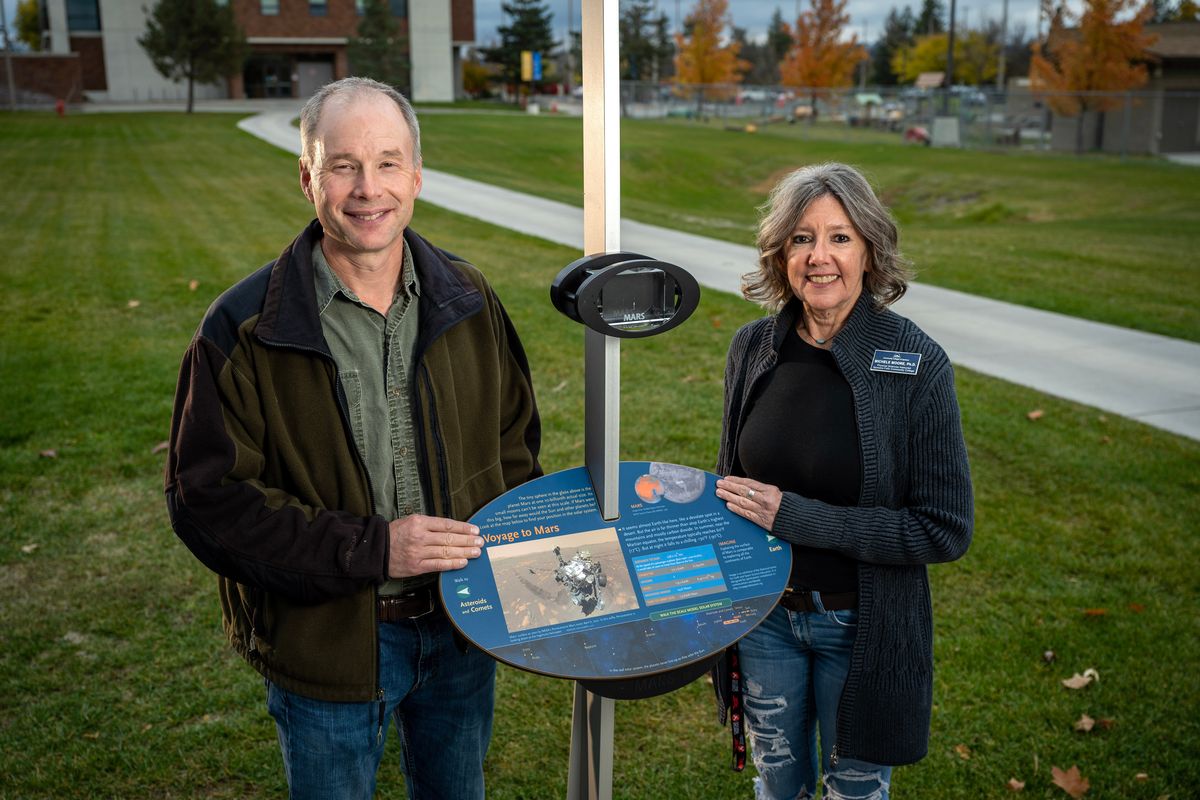SFCC reopens planetarium with interactive campus solar system

When the planetarium at Spokane Falls Community College puts on its first public show since the start of the COVID-19 pandemic this weekend, attendees will have a chance to walk among the planets in a scaled model of the solar system that spans the campus.
The model starts with the sun near the Science building on the east side of campus and ends 530 meters away with Pluto where the main walkway intersects Elliot Drive. Students can view the neighboring planets of Mercury, Venus and Earth on side-by-side stanchions, while the distance from Jupiter to Saturn and the outer planets turns into a long walk.
The installation helps conceptualize the vastness of space, said Michele Moore and John Whitmer, co-directors of the SFCC planetarium.
The 1 to 10 billion scale model not only represents the relative distance between the sun and the planets, but also their relative size. The sun is about the size of a grapefruit, while Earth is a small dot and the dwarf planet Pluto is a pinprick. The model includes some of the solar system’s largest moons next to their planets for comparison.
“That’s the thing about a scaled model of the solar system,” Whitmer said, “there’s no way to display it. You have to walk through it to truly get the size. Otherwise, if you tried to make a picture of it, the size of the planets would be too small to see.”
Whitmer used to tape balls to the sides of buildings on campus and walk his students through the same scale. “It always seemed impactful to the students,” he said. “They got a lot out of it.”
Now the Voyage Solar System is a permanent exhibit on campus, installed just a month ago. It is the same model that is on the National Mall in Washington D.C., designed by the National Center for Earth and Space Science.
While other colleges and universities applied for the project, SFCC was one of the few to be approved, Whitmer said. The model was funded with an Innovation Grant from SFCC for $46,000.
Moore encourages the public to view the model. “It’s a great promotional tool for us from an outreach perspective,” she said. When K-12 students visit the campus, it will be another engaging activity for teachers to do with their classes along with the planetarium.
The planetarium will host public shows this Friday, Saturday and Sunday featuring its new $152,400 projector.
Before the pandemic, the planetarium used two projectors that displayed images over two hemispheres across the ceiling, which was obvious at times due to a visible seam in the imagery. “Now we have a laser diode single-projector, which is much nicer, brighter, crisper,” Whitmer said.
Shows are about an hour. They begin with a virtual tour of the current night sky in Spokane, highlighting stars and constellations that people can then go outside and find in real life.
The second half of the show is a movie projected onto the planetarium’s full dome. This weekend’s movie, which has not been shown at the planetarium before, is “Dark Universe” from the American Museum of Natural History, narrated by astrophysicist and science popularizer Neil deGrasse Tyson.
A Saturday 4 p.m. show is geared for audiences under sixth grade and shows the movie “Earth, Moon and Sun.”
The other shows are perfectly kid-friendly, Moore said, but while they are visually stimulating, sometimes the content is a little advanced for a younger age group.
Tickets are $7 for adults and $5 for children 3-18 and Community Colleges of Spokane students with valid ID. Tickets can be purchased on the Planetarium’s webpage.
The 52-seat planetarium is in the Science building on the SFCC campus.
The next set of public shows will be the first weekend in December.